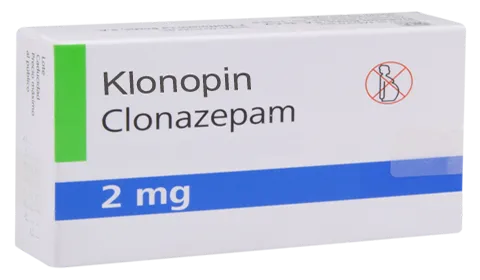Buy Klonopin (Clonazepam) Online Without Prescription in US

| Drug Name: | Klonopin (Clonazepam) |
|---|---|
| Tablet Strength: | 120 pills x 2mg |
| Best Price: | $ 2.45 Per Pill |
| Where to buy: | OnlinePharmacy |
Why Klonopin Prescribed?
Klonopin (clonazepam) is a benzodiazepine medication commonly used to treat epilepsy and anxiety. It is also used off-label to treat anxiety, certain mobility problems. However, short-term use is generally recommended due to the potential for tolerance, addiction, and withdrawal symptoms.
Klonopin is most often prescribed for its anxiolytic (anti-anxiety), anticonvulsant (anti-epileptic) and muscle relaxant properties. If you are taking Klonopin for anxiety, this may help you understand how the drug works.
Prescribing Klonopin should be carefully considered under the supervision of a qualified physician, weighing its benefits against the risk of addiction and side effects.
What is the use of Klonopin?
Klonopin (clonazepam) is a benzodiazepine approved for the treatment of epilepsy and anxiety. It is also sometimes used as a second-line treatment for other anxiety-related mental health conditions, such as social anxiety disorder (SAD).
Klonopin belongs to the benzodiazepine drug class. It works by increasing the effects of a neurotransmitter in the brain called gamma-aminobutyric acid (GABA). GABA helps reduce neural activity by causing stress in the central nervous system.
This can reduce anxiety, relax muscles, reduce seizures, and sometimes act as a sedative. It is important to understand Klonopin’s risks, precautions, warnings, and possible drug interactions so you know how to use this medication and decide whether stress treatment is right for you.
Forms of Klonopin available
Klonopin (clonazepam) comes in many forms, including:
- Tablets: These are the most common form of Klonopin and usually come in a variety of strengths, in 0.5 mg, 1 mg, 2 mg
- Orally disintegrating tablets (ODT): These tablets dissolve quickly in the mouth without the need for water, making it easier for people who can swallow easily.
- Oral solution: Clonazepam is also available in liquid form, which can be measured with a dropper or dosing spoon for accurate dosage, especially if the dosage needs to be changed.
These different forms provide options for people who have preferences or special needs about how to take their medications.
How to use?
Take this medication by mouth as directed by health consultant, usually 2 or 3 times a day. Dosage is depending on your condition, age and response to treatment. For children, dosage is determined by weight. Adults usually start with a lower dose to minimize side effects. Do not increase your dose, take it more often, or take it for longer than directed.
Use this medicine regularly for maximum benefit. Take it at the same time every day to help you remember. Do not use this medicine without consulting your doctor. Some cases may get worse when the medication is stopped suddenly. Your dose may need to be reduced. This medicine may not be effective when used for a long time. If these medications don’t work, talk to your doctor.
Although it helps many people, this drug can be addictive. This risk may be higher if you have a substance abuse disorder (such as drug/alcohol or opiate addiction). To reduce the risk of addiction, take this medication exactly as directed. Consult your doctor or pharmacist for more details.
If you have multiple epilepsy, you may have a seizure when you start using clonazepam. In such a case, consult your doctor immediately. Your doctor may need to add or adjust the dosage of other medications to control seizures.
How long does it take to Klonopin effect?
Because Klonopin is a long-acting benzodiazepine, it takes longer to work than other antidepressants but remains in the body longer. It can start working within minutes and takes 1-4 hours to see full effects.
After a single dose of 2 mg micronized clonazepam in healthy adults, peak blood levels of 6.5- 13.5 ng/mL are usually reached within 1-2 hours. However, in some people, blood concentrations rise within 4 to 8 hours. Klonopin will reach peak blood concentrations within 1 to 4 hours, but you may feel some sedation sooner than that.
The effects of clonazepam can last up to 12 hours. Clonazepam is known as “highly metabolized”, meaning it is mostly processed by the body. Very little of this remains unchanged in the body, and only 2% of Klonopin is excreted unmetabolized in the urine.
Side effects of Klonopin
This is rare, but some people can experience serious side effects while taking clonazepam.
- The whites of your eyes turn yellow or your skin turns yellow, but this is less common with
brown or black skin – this can be a sign of liver problems. - You see or hear things that are not there (hallucinations) or believing things that are not true (delusions).
- Coordination or have problems controlling movements.
- Swelling in your ankle, rapid heartbeat, cough and fatigue – This could be a heart problem.
- You may get angry easily, get tired, experience nosebleeds and shortness of breath – this is a blood problem.
- You notice changes in your mood, such as talking more than usual, feeling overexcited, not get tired, irritable or aggressive – these symptoms are more common in children or if you are over 65.
Long-Term Side Effects
If you take Clonazepam for a long time, it may cause withdrawal symptoms. If you have been using Clonazepam for more than 4 weeks, you can gradually reduce your dose when you stop taking it to prevent withdrawal symptoms.
Other side effects
These are not all the side effects of clonazepam. See the leaflet in your medicine pack for a full list.
Does Klonopin Improve Mood and Quality of Life?
Klonopin (clonazepam) is a benzodiazepine that treats anxiety and seizures by modulating the neurotransmitter gamma-aminobutyric acid (GABA) in the central nervous system. Its anxiolytic properties may reduce symptoms such as excessive anxiety, worry, and fear, which may improve the mood and quality of life of people with anxiety disorders.
However, it is not often used as an effective intervention in the treatment of mental disorders such as depression due to concerns about addiction, dependence, and more depression with long-term use.
While Klonopin may provide some relief from psychological distress, significant and meaningful improvements in mood and well-being often require treatment that includes treatment, lifestyle changes, and possibly other side effects.
Therefore, although Klonopin may play a role in symptom management, its direct effect on improving mood and quality of life is limited and should be part of the clinical regimen as directed by an appropriate physician.
